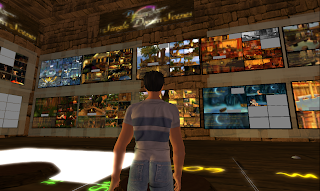
distinctly different. I chose Harry Potter: And the Order of the Phoenix, a direct film to game adaptation; Lord of the Rings: Conquest, a game that follows the story in the film but gives you control of characters who were not and Batman: Arkham Asylum a game not directly based off of a film but set in the same world. While playing the three games I kept in mind Trevor Elkington's essay "Media Convergence and Self-Defeating Adaptations. The Key Ideas I want to focus on are: 1. Games based on films are often criticized due to the failure to translate the
medium effectively and 2. A statement in Trevor Elkington's essay " What video game consumers seek from adaptations is not a simple, interactive rehearsal of film events but in fact further expansion of a narrative world via an engaged relationship with an interactive
medium."

The first game I played was Harry Potter: And the Order of the Phoenix. I chose this game because it seemed like it would be a great example of a direct adaptation. The game opens up similar to the movie, panning over Hogwarts until it finally gives you control of Harry Potter. The first thing the game has you do is use your magic wand to lift things. Lifting and moving items is your only ability and all I was able to accomplish in the demo was lifting trophies back
on to a shelf. The game starts out with a lot of promise and it feels like it could be an open world exploration of Hogwarts (above image) but it is very linear. The game did surprise me by not following the story from the movie at all but it seemed to show what happened in-between events in the story which involves a lot of walking around and cleaning up trophies. The problem with the game really stems back to key concept #1 and the developers failure to translate a worth while Harry Potter experience.

The second game I played was Lord of the Rings: Conquest and I really had high hopes for this one. Before playing it I was hoping to use it as an example of what can be done right in a film to game adaptation. After playing the game I can say I had a more enjoyable experience cleaning up rooms in Harry Potter. The game starts out with the same cut scenes they show at the beginning of every Lord of the Rings game. After this you are given control of a warrior character and you have to follow other warrior characters who look exactly like you down a path. You are then locked into a circular area where orcs are coming at you and you can push one of three buttons to kill them. This is basically the entire game, you play through scenes from Lord of the Rings one enclosed area at a time. The only difference is you get to play as
background characters in the movie who have a few limited abilities and are similar to the main characters in the story but are definitely not as cool. In fact they all look exactly the same, it is hard to tell what class you are. If that's not bad enough everyone you fight in the game also looks exactly the same, it's just the same character model running after you over and over (above image). This game also relates to key concept #1 but almost worse. It is the same story from the film but with lame characters.

The third game I played was easily the best of the three and really relates to key concept #2. In Batman: Arkham Asylum you take the role of Batman in an original story that sends you chasing the Joker throughout Arkham Asylum. This game isn't directly based of any Batman film, comic, or TV show but rather takes elements from all of these and creates a really enjoyable experience. Even the art design is original in this game and all the characters look
familiar but different and more stylized (above image). This game really enriches the world of Batman by giving you a great, complete game and a story that adds to all of the characters in the Batman world. This game really showcases what can go right in the development of a film to game adaptation.



